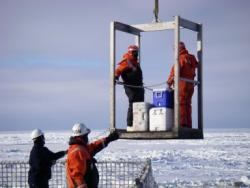Yesterday (4/18/07) I got to do something VERY exciting! I took my first trip out onto the ice!! Whoo hoo! It was really neat to be able to walk on the Bering Sea. The ice at this location was very thick- around 9-10 feet thick.
A group of scientists were sent out to do some coring of the ice- we drill a hole into the ice with a hollow tube, and it takes a long section of ice out. Then we wrap it in plastic and take it back to the lab on the ship for analyzing. We collected many cores, and each person who wants one is analyzing something different- some people are looking at the metals that get trapped in the ice, some are interested in the zooplankton and phytoplankton that are trapped in the ice, some are interested in the salt that gets trapped in the ice (when ice forms on the ocean, most of the salt gets squeezed out during ice formation- some of it sticks around, however, in little pools inside the ice called "brine pockets”), and some are interested in the gas bubbles that are trapped in the ice. Our group is interested in the gas that is trapped in the ice- specifically the radon gas- which we’re going to try and use to figure out how old the ice is. This isn’t something we planned on doing when we came on the cruise- but that’s what science is all about- trying something new! So off I went, onto the ice, to collect a core! A lot of the ice in the area we cored in was "dirty”- which means it had a lot of sediment from the ocean floor frozen into the ice. This is commonly found in shallow areas, where there is a lot of mixing of the ocean water (due to wind storms). The sea freezes and the dirt gets trapped inside. Most of the ice around here is brown on the bottom, which is not caused by dirt, rather it is diatoms and other phytoplankton growing in the ice!
 Ice Path
Ice Path
See all the brown on the bottom of this ice? This is not dirty ice, it’s diatoms
trapped inside the ice- they’re still alive, just growing inside the ice!
When anyone goes out onto the ice, they always send down a Coast Guard member first so that they can test out the ice and make sure it’s solid and safe to walk on. They send down someone who is a rescue diver and dressed in their diving gear, so that if they were to fall through, they would be safe in the VERY cold water. Once they’ve determined the ice is safe, they send the scientists down. We all have to wear special gear because it is very cold out on the ice! We wear these large white boots called "bunny boots” that keep your feet nice and toasty warm. They trap air inside them, and the air gets heated by your body heat. We also have to put on a dry suit- which is a suit that has air tight seals around the neck and wrists, and has feet on the bottom that your feet slide into, so no cold air gets in, and the air inside is warmed by your body heat. We also have to wear helmets when traveling inside the man basket, and many of us were ski masks or "balaclavas” that cover our faces and heads so we don’t get cold. And of course, gloves to keep your hands warm! A nice pair of waterproof gloves are always handy when working with icy cold water. Brr!!
 Rescue Diver
Rescue Diver
Rescue diver, keeping watch (and looking a bit bored!)
 Bunny Boots
Bunny Boots
Bunny boots! These keep your feet nice and toasty warm while on the ice.
 Dry Suits
Dry Suits
Dry suits in action! That’s me on the ice, all suited up, waving at the camera!
 Man Basket 2
Man Basket 2
Riding down in the man basket (yes, that’s me again!)
 Ice Drill
Ice Drill
Drilling into the ice.
 Ice Hole
Ice Hole
The hole made by the drill- about 6 ft deep or so…
 Healy View
Healy View
A rare view of the Healy, she’s HUGE!!
 Emily Core
Emily Core
Our ice core!! Tada!!! It was 70cm long…
 Snow Angels
Snow Angels
Couldn’t resist making a snow angel while on the ice!!

